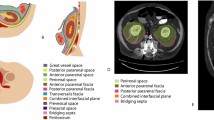Abstract
The primary retroperitoneal tumors form a rare and diverse group of neoplasms, the origin of which is independent of the various retroperitoneal organs and unrelated to systemic diseases, such as lymphomas, lymphadenopathy, or metastases. Radiologic investigation, mainly cross-sectional imaging and, to a lesser extent, angiography is essential in the diagnosis and management of these tumors. The radiologist often is challenged to identify the origin and specific tissue composition of the imaged neoplasms. When the radiologic findings are combined with patient information and clinical data, the correct diagnosis may be made in many cases. Imaging-guided percutaneous needle biopsy further enhances the diagnostic yield of the various imaging modalities by establishing the diagnosis without the need for exploration.
Similar content being viewed by others
References
Ackerman LV: Tumors of the retroperitoneum, mesentery and peritoneum. InAtlas of Tumor Pathology, section VI, Fascicles 23, 24. Washington, D.C.: Armed Forces Institute of Pathology, 1954, pp 12–13
Patel SK: Retroperitoneal tumors and cysts. In: Pollack HM (ed):Clinical Urography. Philadelphia: W.B. Saunders, 1990, pp 2413–2457
Lane RH, Stephens DH, Reiman HM: Primary retroperitoneal neoplasms: CT findings in 90 cases with clinical and pathologic correlation.AJR 152:83–89, 1989
Krol G, Sundaresan N, Deck M: Computed tomography of axial chordomas.J Comput Assist Tomogr 7:286–289, 1983
Schey WL, Shkolnick A, White H: Clinical and radiographic considerations of sacrococcygeal teratomas: An analysis of 26 new cases and review of the literature.Radiology 125:189–195, 1977
Hartman DS: Retroperitoneal tumors and lymphadenopathy.Urol Radiol 12:132–134, 1990
Davidson AJ, Hartman DS: Lymphangioma of the retroperitoneum: CT and sonographic characteristics.Radiology 175:507–510, 1990
Davidson AJ, Hartman DS, Goldman SM: Mature teratoma of the retroperitoneum: Radiologic, pathologic and clinical correlation.Radiology 172:421–425, 1989
Goldman SM, Hartman DS, Weiss SW: The varied radiographic manifestations of retroperitoneal malignant fibrous histiocytoma revealed through 27 cases.J Urol 135:33–38, 1986
McLeod AJ, Zornoza J, Shirkhoda A: Leiomyosarcoma: Computed tomographic findings.Radiology 152:133–136, 1984
Lee JKT: Magnetic resonance imaging of the retroperitoneum.Urol Radiol 10:48–51, 1988
Amis ES Jr: Retroperitoneal fibrosis.Urol Radiol 12:135–137, 1990
Gross MD, Shapiro B: Scintigraphic localization of adrenal disease. In: Pollack HM (ed):Clinical Urography. Philadelphia, W.B. Saunders, 1990, pp 2376–2387
Author information
Authors and Affiliations
Rights and permissions
About this article
Cite this article
Papanicolaou, N., Yoder, I.C. & Lee, M.J. Primary retroperitoneal neoplasms: How close can we come in making the correct diagnosis. Urol Radiol 14, 221–228 (1992). https://doi.org/10.1007/BF02926936
Issue Date:
DOI: https://doi.org/10.1007/BF02926936




